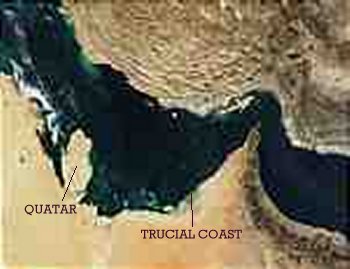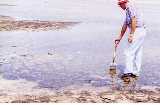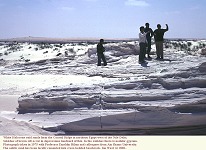
locality 4
BEACH AREA
Evaporite minerals occur in the upper intertidal and supratidal zones of the sabkha
A broad shelf extends seawards, mantled with coral reefs and skeletal sand and gravel in the shoal areas and carbonate muds in the hollows.
Lagoons are floored with muddy skeletal sand that grades landwards to peloid sands and algal mats, tidal inlets are floored with ooid sands (McLane, 1995).
Microbial mats characterise the upper intertdal sediments, forming in the areas too hostile for grazing certhid gastropods.
In the lagoon area polygonally cracked algal-mats occur in hypersaline water at the intertidal margin like this one seen at Umm Said, Quatar.

Source http://visibleearth.nasa.gov/
Satellite image map of quatar and the Trucial Coast
Below the sabkha surface older microbal mats are compacted into peats. Discoidal gypsum crystals occur in these sediments, with local cementation by aragonite, magnesite and protodolomite (West's Geology Fieldtrips).

source http://www.soton.ac.uk/~imw/sabkha.htm
Algal-mat seen at Umm Said Quatar
Supratidal sediments overlie the algal peats and are predominantly formed of reworked shallow marine carbonates and siliciclastic sands.
In this area white beach ridges of carbonate sands often develop. The white sand is made up of spherical ooids with nuclei of quart.
These sediments are introduced by winds or onshore storm surges.In some cases the oolitic sands are cemented into beachrock. It is these sediments that host gypsum and anhydrite (West's Geology Fieldtrips).

source http://www.soton.ac.uk/~imw/sabkha.htm
White oolitic beachrock
Away from the shore , microbial mats/peats become increasingly disrupted by growth of lensoid crystals of gypsum, which may, inplaces, form a distinct layer of crystal mush.
Where marine flooding occurs at intervals of less than once a month, anhydrite nodules appear within the supratidal sediments, sediments which have now been largely replaced by magnesite and dolomite.
This page was created by Pamela Williams
Last Modified:18/06/02